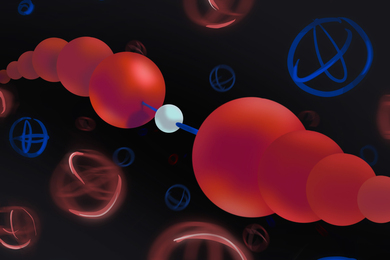A team of astronomers led by Lynn D. Matthews at the MIT Haystack Observatory has discovered a disk of gas swirling close to a young massive star, which they say offers the first evidence that massive stars form similarly to smaller stars. Because massive stars are believed to be responsible for creating most of the chemical elements in the universe that are critical for the formation of Earth-like planets and life, understanding how they form may help unravel mysteries about the origins of life.
Until now, it had been difficult to prove how massive stars form because they are rare, form very quickly and tend to be enshrouded in dense, dusty material, making it hard to observe them. By using the National Science Foundation’s Very Long Baseline Array (VLBA) radio telescope to take images of the wavelengths of light emitted by a massive young star located 1,350 light years away in the Orion constellation, Matthews’ team has produced a high-resolution time-lapse movie that reveals a disk rotating around the star, known as Source I (when spoken, “Source Eye”).
“It is the first really ironclad confirmation that massive young stars are surrounded by orbiting accretion disks, and the first strong suggestion that these disks launch magnetically driven winds,” said University of California at Santa Cruz astronomy and astrophysics professor Mark Krumholz of the time-lapse movie, which is described in a paper published in the Jan. 1 issue of the Astrophysical Journal.
For almost 20 years, astronomers have known that low-mass stars form as a result of disk-mediated accretion, or from material formed from a structure rotating around a central body and driven by magnetic winds. But it had been impossible to confirm whether this was true for massive stars, which are eight to 100 times larger than low-mass stars. Without any hard data, theorists proposed many models for how massive stars might form, such as via collisions of smaller stars. “This work should rule out many of them,” Krumholz said of Matthews’ movie.
Until now, it had been difficult to prove how massive stars form because they are rare, form very quickly and tend to be enshrouded in dense, dusty material, making it hard to observe them. By using the National Science Foundation’s Very Long Baseline Array (VLBA) radio telescope to take images of the wavelengths of light emitted by a massive young star located 1,350 light years away in the Orion constellation, Matthews’ team has produced a high-resolution time-lapse movie that reveals a disk rotating around the star, known as Source I (when spoken, “Source Eye”).
“It is the first really ironclad confirmation that massive young stars are surrounded by orbiting accretion disks, and the first strong suggestion that these disks launch magnetically driven winds,” said University of California at Santa Cruz astronomy and astrophysics professor Mark Krumholz of the time-lapse movie, which is described in a paper published in the Jan. 1 issue of the Astrophysical Journal.
For almost 20 years, astronomers have known that low-mass stars form as a result of disk-mediated accretion, or from material formed from a structure rotating around a central body and driven by magnetic winds. But it had been impossible to confirm whether this was true for massive stars, which are eight to 100 times larger than low-mass stars. Without any hard data, theorists proposed many models for how massive stars might form, such as via collisions of smaller stars. “This work should rule out many of them,” Krumholz said of Matthews’ movie.






